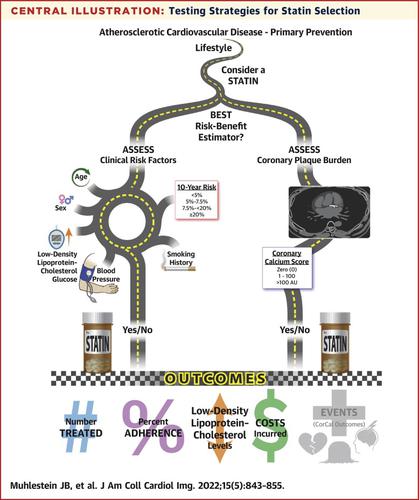JACC: Cardiovascular Imaging ( IF 14.0 ) Pub Date : 2021-12-15 , DOI: 10.1016/j.jcmg.2021.11.006 Joseph B Muhlestein 1 , Kirk U Knowlton 1 , Viet T Le 2 , Donald L Lappe 1 , Heidi T May 3 , David B Min 3 , Kevin M Johnson 3 , Shanelle T Cripps 3 , Lesley H Schwab 3 , Shelbi B Braun 3 , Tami L Bair 3 , Jeffrey L Anderson 1

|
Objectives
This study sought to determine the feasibility of performing an extensive randomized outcomes trial comparing a coronary artery calcium (CAC)- versus a pooled cohort equations (PCE) risk score–based strategy for initiating statin therapy for primary atherosclerotic cardiovascular disease (ASCVD) prevention.
Background
Statin therapy is standard for the primary prevention of ASCVD in subjects at increased risk. National guidelines recommend using the American College of Cardiology/American Heart Association PCE risk score to guide a statin recommendation. Whether guidance by a CAC score is equivalent or superior is unknown.
Methods
CorCal (Effectiveness of a Proactive Cardiovascular Primary Prevention Strategy, With or Without the Use of Coronary Calcium Screening, in Preventing Future Major Adverse Cardiac Events) was a randomized trial consenting 601 patients without known ASCVD, diabetes, or prior statin therapy recruited from primary care clinics and randomized to CAC- (n = 302) or PCE guidance (n = 299) of statin initiation for primary prevention. Enrolled subjects and their physicians made final treatment decisions. Primary outcomes compared the proportion of statin recommendations received and subject adherence over 1 year between CAC- and PCE-arm subjects. Modeled medical costs, adverse effects, and low-density lipoprotein–cholesterol (LDL-C) were additional measures of interest.
Results
Subjects were well matched, and 540 (89.9%) completed entry testing and received a protocol-based recommendation. A statin was recommended in 101 (35.9%) CAC-arm and 124 (47.9%) PCE-arm subjects (P = 0.005). Compared to PCE-based recommendations, CAC-arm subjects were reclassified from statin to no statin in 36.0% and from no statin to statin in 5.6% of cases, resulting in a total reclassification of 20.6%. Physicians accepted the study-dictated recommendation to start a statin in 88.1% of CAC-arm vs 75.0% of PCE-arm subjects (P = 0.01). Patient-reported adherence to this recommendation at 3 months was 62.2% vs 42.2%, respectively (P = 0.009). At 1 year, statin adherence remained superior, LDL-C levels were lower, estimated costs were similar or reduced in CAC subjects, and few events occurred.
Conclusions
CAC guidance may be a more efficient, personalized, cost-effective, and motivating approach to statin initiation and maintenance in primary prevention. This feasibility phase of CorCal should be regarded as hypothesis-generating with respect to cardiovascular outcomes, which is being addressed in a large, longer-term outcomes trial. (Effectiveness of a Proactive Cardiovascular Primary Prevention Strategy, With or Without the Use of Coronary Calcium Screening, in Preventing Future Major Adverse Cardiac Events [CorCal]; NCT03439267)
中文翻译:

用于一级预防指导的冠状动脉钙与汇总队列方程评分
目标
本研究旨在确定开展一项广泛的随机结果试验的可行性,该试验比较了基于冠状动脉钙化 (CAC) 与基于汇总队列方程 (PCE) 风险评分的策略,以启动他汀类药物治疗预防原发性动脉粥样硬化性心血管疾病 (ASCVD)。
背景
他汀类药物治疗是高危受试者 ASCVD 一级预防的标准疗法。国家指南建议使用美国心脏病学会/美国心脏协会 PCE 风险评分来指导他汀类药物的推荐。CAC 分数的指导是否等同或优越尚不清楚。
方法
CorCal(主动心血管初级预防策略的有效性,无论是否使用冠状动脉钙筛查,在预防未来主要不良心脏事件方面的有效性)是一项随机试验,同意从初级保健招募 601 名未已知 ASCVD、糖尿病或先前他汀类药物治疗的患者并随机分配到 CAC- (n = 302) 或 PCE 指导 (n = 299) 开始他汀类药物的初级预防。入组受试者及其医生做出最终治疗决定。主要结果比较了在 CAC 组和 PCE 组受试者之间收到的他汀类药物建议的比例和受试者在 1 年内的依从性。模型化的医疗费用、不良反应和低密度脂蛋白胆固醇 (LDL-C) 是额外的关注指标。
结果
受试者匹配良好,540 人 (89.9%) 完成了入门测试并获得了基于协议的推荐。101 名(35.9%)CAC 组和 124 名(47.9%)PCE 组受试者建议使用他汀类药物(P = 0.005)。与基于 PCE 的建议相比,36.0% 的 CAC 组受试者从他汀类药物重新分类为无他汀类药物,5.6% 的病例从无他汀类药物重新分类为他汀类药物,总重新分类率为 20.6%。医生接受了研究规定的建议,即在 88.1% 的 CAC 组和 75.0% 的 PCE 组受试者中开始使用他汀类药物(P = 0.01)。患者报告的 3 个月时对该建议的依从性分别为 62.2% 和 42.2% (P =0.009)。在 1 年时,他汀类药物的依从性仍然优越,LDL-C 水平较低,CAC 受试者的估计成本相似或降低,并且很少发生事件。
结论
CAC 指导可能是一种更有效、更个性化、更具成本效益和激励性的方法,用于在一级预防中启动和维持他汀类药物。CorCal 的这个可行性阶段应该被视为关于心血管结果的假设生成,这正在一项大型、长期结果试验中得到解决。(主动心血管一级预防策略的有效性,无论是否使用冠状动脉钙筛查,在预防未来主要不良心脏事件中的有效性 [CorCal];NCT03439267)


























 京公网安备 11010802027423号
京公网安备 11010802027423号